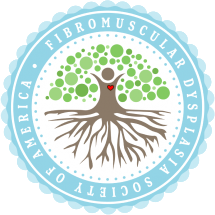Genomics of Fibromuscular Dysplasia
This study was conducted by Alexandre Persu and his team of FMD researchers out of UCL located in Brussels.
Abstract: Fibromuscular Dysplasia (FMD) is “an idiopathic, segmental, non-atherosclerotic and noninflammatory disease of the musculature of arterial walls, leading to stenosis of small and mediumsized arteries” (Persu, et al; 2014). FMD can lead to hypertension, arterial dissections, subarachnoid haemorrhage, stroke or mesenteric ischemia. The pathophysiology of the disease remains elusive. While familial cases are rare (<5%) in contemporary FMD registries, there is evidence in favour of the existence of multiple genetic factors involved in this vascular disease. Recent collaborative efforts allowed the identification of a first genetic locuzs associated with FMD. This intronic variant located in the phosphatase and actin regulator 1 gene (PHACTR1) may influence the transcription activity of the endothelin-1 gene (EDN1) located nearby on chromosome 6. Interestingly, the PHACTR1 locus has also been involved in vascular hypertrophy in normal subjects, carotid dissection, migraine and coronary artery disease. National and international registries of FMD patients, with deep and harmonised phenotypic and genetic characterisation, are expected to be instrumental to improve our understanding of the genetic basis and pathophysiology of this intriguing vascular disease. May 2018


 Since ancient times and across many cultures, the tree has long been a symbol of many things, including wisdom, protection, strength, inter-connectivity, and life itself. We’ve chosen the tree to represent the Fibromuscular Dysplasia Society of America for these reasons, and because the tree’s branches and roots signify the arteries affected by this disease. The tree’s branches, reaching upward and outward, provide protection and shelter, and represent our mission to help those who’ve been diagnosed with FMD. Trees, strengthened by their continuously spreading roots, symbolize how as we grow together we are stronger and more resilient. As with its growth from a delicate sapling to a giant robust tree, and as its branches and roots grow and spread, the tree symbol represents how we’ve evolved and continue to promote research, education and patient support throughout the years. Together we can achieve much, as we strive to reach for the sky.
Since ancient times and across many cultures, the tree has long been a symbol of many things, including wisdom, protection, strength, inter-connectivity, and life itself. We’ve chosen the tree to represent the Fibromuscular Dysplasia Society of America for these reasons, and because the tree’s branches and roots signify the arteries affected by this disease. The tree’s branches, reaching upward and outward, provide protection and shelter, and represent our mission to help those who’ve been diagnosed with FMD. Trees, strengthened by their continuously spreading roots, symbolize how as we grow together we are stronger and more resilient. As with its growth from a delicate sapling to a giant robust tree, and as its branches and roots grow and spread, the tree symbol represents how we’ve evolved and continue to promote research, education and patient support throughout the years. Together we can achieve much, as we strive to reach for the sky.